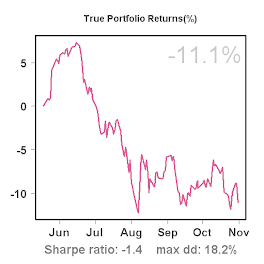Longstoch-ST Alpha and Beta
An important question when deciding on including a system is whether it merely tracks an index (possibly leveraged), or whether it is capable of showing good performance irrespective of what the broader market does.
This question can be answered by examining alpha and beta, which are two coefficients obtained after regressing a system's returns on an index' returns. I estimated alpha and beta for Longstoch-ST, their 95% confidence intervals, and the fit of the model (R-squared) using daily, weekly and monthly returns. The index is the S&P500 and results are shown below:
The first thing to notice is that the model fit is extremely poor, as the R-squared is only 0.13 (using daily returns), which means that only 13% of the movement of Longstoch-ST can be explained my the movement of the S&P500. This is good news! The lower the R-squared the better, as I like to deal with vendors capable of picking winning trades without just taking advantage of the index (which, as we all know, did quite well over the last year). The only disadvantage of a low R-squared is that interpreting the alpha and beta coefficients becomes less meaningful.
Still, they look the way we want them to look: positive alpha and beta < 1. Using weekly returns, alpha is 0.59, meaning the system generated an average return of 0.59% per week in excess of any S&P500 return. Ideally, alpha would be statistically different from zero, indicated by a lower bound of the 95% confidence interval greater than zero. We can see that alpha is statistically different from zero for both weekly and monthly returns but not for daily returns. Beta is 0.64 for daily returns, meaning that when the S&P500 index was up (down) 1%, Longstoch-ST was up (down) 0.64% on average. In other words: the system generated returns in excess of the S&P500, with less volatility than this index. That's the best you can get!
Also of interest is the negative sign for monthly betas. It suggests that on a monthly basis the system would be up when the index would be down. However, the number of observations (N) is only 11 and the fit of the model poor, so it doesn't mean anything at this point.
Of course, we don't have to restrict ourselves to the S&P500 index. I repeated the same exercise for 36 other indices (shown at the bottom of this post), and picked the ones with the best fit (highest R-squared):
It apparently pays off to examine other indices as well, because the fit (R-squared) has improved a lot for both weekly and monthly data. Apparently the Nasdaq Bank index is a better matching index than the S&P500 at the weekly level. However, I consider these figures still very low: Out of the 37 indices considered, none was able to explain more than 25% of the variance of the system's returns. With better fitting indices we basically see the same pattern for alpha (positive) and beta (smaller than one). All in all, these statistics played a major role in picking this system and I hope the system will continue to show low R-squared, small beta and (most important) positive alpha.
The indices I included were:
DOW JONES COMPOSITE INDEX
DOW JONES INDUSTRIAL AVERAGE IN
DOW JONES TRANSPORTATION AVERAG
DOW JONES UTILITIES INDEX
NYSE COMPOSITE INDEX
NYSE International 100
NYSE TMT
NYSE US 100
NYSE World Leaders
NASDAQ BANK
NASDAQ BIOTECHNOLOGY (DRM)
NASDAQ COMPOSITE
NASDAQ COMPUTER
NASDAQ FINANCIAL 100
NASDAQ INDUSTRIAL
NASDAQ INSURANCE
NASDAQ NNM COMPOSITE
NASDAQ OTHER FINANCE
NASDAQ TELECOMMUNICATIONS
NASDAQ TRANSPORTATION
NASDAQ-100 (DRM)
S&P 100 INDEX
S&P 400 MIDCAP INDEX
S&P COMPOSITE 1500 INDEX
S&P SMALLCAP 600 INDEX
AMEX COMPOSITE INDEX
AMEX INTERACTIVE WEEK INTERNET
AMEX NETWORKING INDEX
DJ WILSHIRE 5000 TOT
MAJOR MARKET INDEX
NYSE Arca Tech 100 Index
PHLX SEMICONDUCTOR SECTOR INDEX
PHLX THESTREET.COM INTERNET SEC
RUSSELL 1000 INDEX
RUSSELL 2000 INDEX
RUSSELL 3000 INDEX




No comments:
Post a Comment